Difference between revisions of "Post Exchange"
Rebollo fr (talk | contribs) m (ultra minor) |
(typo) |
||
| (14 intermediate revisions by 3 users not shown) | |||
| Line 1: | Line 1: | ||
The '''Post Exchange''' (or PX) facilities are trading posts located in bases of the US Army or US Air Force, and operated by the Army & Air Force Exchange Service.<REF> [http://en.wikipedia.org/wiki/Base_exchange Base exchange] at Wikipedia. </REF> Equivalent facilities in bases of the US Navy are called '''Naval Exchange'''. | The '''Post Exchange''' (or PX) facilities are trading posts located in bases of the US Army or US Air Force, and operated by the Army & Air Force Exchange Service.<REF> [http://en.wikipedia.org/wiki/Base_exchange Base exchange] at Wikipedia. </REF> Equivalent facilities in bases of the US Navy are called '''Naval Exchange'''. | ||
| − | Many Japanese products (not only cameras) sold in the | + | Many Japanese products (not only cameras) sold in the Allied Army military bases in Japan and abroad were stamped with special markings. The products sold in PX stores were not subject to the same high taxes as those sold in Japan's domestic market, and the markings were applied to avoid tax evasion by domestic Japanese buyers. EP products were shipped throughout the world for all Allied Armies of WW2. |
| − | The earliest marking, used around 1948–49, is a diamond-shaped engraving containing the Roman letters ''CPO'' or their ''katakana'' equivalent シーピーオー. "CPO" is said to stand for <u>C</u>entral <u>P</u>urchasing <u>O</u>ffice,<REF> See for example Dechert, p.68. </REF> | + | The earliest marking, used around 1948–49, is a diamond-shaped engraving containing the Roman letters ''CPO'' or their ''katakana'' equivalent シーピーオー. "CPO" is said to stand for <u>C</u>entral <u>P</u>urchasing <u>O</u>ffice,<REF> See for example Dechert, p.68. </REF> an office of the occupation army of the USA under General Douglas MacArthur's command.<REF>"The Central Purchasing Office is established as a special staff section of General Headquarters, Far East Command, for the purpose of purchasing indigenous Japanese merchandise for resale to the Post Exchange type systems of the Allied Occupation Forces". And "All CPO marked merchandise found in the possession of other than Allied personnel will be confiscated." ... text from a letter of the GH Far East Command, Nov. 23, 1948</REF> |
| − | The "CPO" marking was | + | |
| + | {{Flickr_image | ||
| + | |image_source= http://www.flickr.com/photos/90900361@N08/in/pool-camerawiki/ | ||
| + | |image= http://farm2.staticflickr.com/1452/24337917466_9cbf552098_m.jpg | ||
| + | |image_align= left | ||
| + | |image_text= Katakana marking <br>on a 1948 Semi Leotax <BR><small>image by Eastwestphoto</small> | ||
| + | |image_by= | ||
| + | |image_rights= wp | ||
| + | }} | ||
| + | |||
| + | {{Flickr_image | ||
| + | |image_source= http://www.flickr.com/photos/90900361@N08/in/pool-camerawiki/ | ||
| + | |image= http://farm2.staticflickr.com/1680/23996327089_f73603c70a_m.jpg | ||
| + | |image_align= left | ||
| + | |image_text= CPO marking on a 1948 Mamiya 6 IV <BR><small>image by Eastwestphoto</small> | ||
| + | |image_by= | ||
| + | |image_rights= wp | ||
| + | }} | ||
| + | |||
| + | {{Flickr_image | ||
| + | |image_source= http://www.flickr.com/photos/90900361@N08/46136162341/in/pool-camerawiki/ | ||
| + | |image= http://farm5.staticflickr.com/4835/46136162341_7b1a62cb8f_m.jpg | ||
| + | |image_align= left | ||
| + | |image_text= Katakana marking on 1948 Konica 1 <BR><small>image by Eastwestphoto</small> | ||
| + | |image_by= | ||
| + | |image_rights= wp | ||
| + | }} | ||
| + | |||
| + | |||
| + | {{br}} | ||
| + | |||
| + | |||
| + | The "CPO" marking was replaced about two years later by an '''<EP>''' marking inside a diamond, either in black or in red. The exact meaning of the letters "<EP>" is not confirmed; they probably do not stand for "<u>E</u>xchange <u>P</u>ost", because the facilities were called the reverse, one suggestion is "<u>E</u>xport <u>P</u>ermitted".<REF> See for example [http://photo.net/leica-rangefinders-forum/008OZ6 this thread at photo.net]. </REF> The ''EP'' marking was perhaps applied until the early 1970s.<REF> Early 1970s: [http://photo.net/nikon-camera-forum/00OHNd this thread at photo.net] mentions an ''EP'' marking on Canon FTb cameras dating 1971–2. </REF> | ||
| + | |||
| + | <EP> most likely stood for ''Export Product'' and was used on many different items, not just cameras. Dates for <EP> are 95% 1948~1955, then slowly phased out as inventories were sold off. WW2 devastated the Japanese economy and sadly the Japanese people could not afford their own products. To avoid paying high domestic taxes and cheating, <EP> was labeled by the Japanese government on all export products sold in PX stores in Japan and throughout the Allied Army world. If a Japanese citizen was found with an Katakana or <CPO> or <EP> stamped product there was a serious fine imposed. A result of this practice was that many Japanese photographers were still using pre war cameras even in 1955.<REF>Researcher and writer on 1938-1950 Japanese cameras Don from Eastwestphoto</REF> | ||
| + | |||
| + | |||
| + | {{Flickr_image | ||
| + | |image_source= http://www.flickr.com/photos/90900361@N08/16885799980/in/pool-camerawiki/ | ||
| + | |image= http://farm8.staticflickr.com/7678/16885799980_729ebc04e8_m.jpg | ||
| + | |image_align= left | ||
| + | |image_text= EP marking on a 1953 Welmy-Six | ||
| + | |image_by= Geoff Harrisson | ||
| + | |image_rights= wp | ||
| + | }} | ||
| + | |||
| + | {{Flickr_image | ||
| + | |image_source= http://www.flickr.com/photos/90900361@N08/11578598893/in/pool-camerawiki/ | ||
| + | |image= http://farm4.staticflickr.com/3678/11578598893_5da08b76c4_m.jpg | ||
| + | |image_align= left | ||
| + | |image_text= EP marking on the viewfinder <br>of a [[Karoron]] camera | ||
| + | |image_by= Geoff Harrisson | ||
| + | |image_rights= wp | ||
| + | }} | ||
| + | |||
| + | {{Flickr_image | ||
| + | |image_source= http://www.flickr.com/photos/90900361@N08/8289936852/in/pool-camerawiki/ | ||
| + | |image= http://farm9.staticflickr.com/8359/8289936852_75692eed4b_m.jpg | ||
| + | |image_align= left | ||
| + | |image_text= EP engraving on Canon 85mm f1.9 lens | ||
| + | |image_by= Geoff Harrisson | ||
| + | |image_rights= wp | ||
| + | }} | ||
| + | |||
| + | {{br}} | ||
== Notes == | == Notes == | ||
Latest revision as of 20:17, 29 October 2020
The Post Exchange (or PX) facilities are trading posts located in bases of the US Army or US Air Force, and operated by the Army & Air Force Exchange Service.[1] Equivalent facilities in bases of the US Navy are called Naval Exchange.
Many Japanese products (not only cameras) sold in the Allied Army military bases in Japan and abroad were stamped with special markings. The products sold in PX stores were not subject to the same high taxes as those sold in Japan's domestic market, and the markings were applied to avoid tax evasion by domestic Japanese buyers. EP products were shipped throughout the world for all Allied Armies of WW2.
The earliest marking, used around 1948–49, is a diamond-shaped engraving containing the Roman letters CPO or their katakana equivalent シーピーオー. "CPO" is said to stand for Central Purchasing Office,[2] an office of the occupation army of the USA under General Douglas MacArthur's command.[3]

|
| Katakana marking on a 1948 Semi Leotax image by Eastwestphoto (Image rights) |
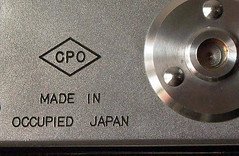
|
| CPO marking on a 1948 Mamiya 6 IV image by Eastwestphoto (Image rights) |
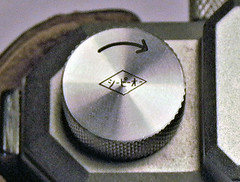
|
| Katakana marking on 1948 Konica 1 image by Eastwestphoto (Image rights) |
The "CPO" marking was replaced about two years later by an <EP> marking inside a diamond, either in black or in red. The exact meaning of the letters "<EP>" is not confirmed; they probably do not stand for "Exchange Post", because the facilities were called the reverse, one suggestion is "Export Permitted".[4] The EP marking was perhaps applied until the early 1970s.[5]
<EP> most likely stood for Export Product and was used on many different items, not just cameras. Dates for <EP> are 95% 1948~1955, then slowly phased out as inventories were sold off. WW2 devastated the Japanese economy and sadly the Japanese people could not afford their own products. To avoid paying high domestic taxes and cheating, <EP> was labeled by the Japanese government on all export products sold in PX stores in Japan and throughout the Allied Army world. If a Japanese citizen was found with an Katakana or <CPO> or <EP> stamped product there was a serious fine imposed. A result of this practice was that many Japanese photographers were still using pre war cameras even in 1955.[6]
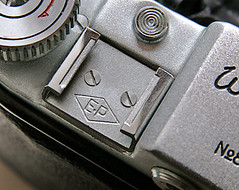
|
| EP marking on a 1953 Welmy-Six image by Geoff Harrisson (Image rights) |
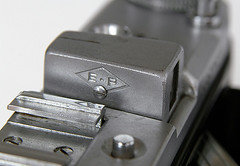
|
| EP marking on the viewfinder of a Karoron camera image by Geoff Harrisson (Image rights) |
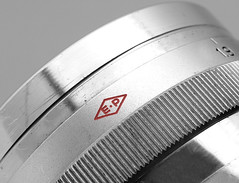
|
| EP engraving on Canon 85mm f1.9 lens image by Geoff Harrisson (Image rights) |
Notes
- ↑ Base exchange at Wikipedia.
- ↑ See for example Dechert, p.68.
- ↑ "The Central Purchasing Office is established as a special staff section of General Headquarters, Far East Command, for the purpose of purchasing indigenous Japanese merchandise for resale to the Post Exchange type systems of the Allied Occupation Forces". And "All CPO marked merchandise found in the possession of other than Allied personnel will be confiscated." ... text from a letter of the GH Far East Command, Nov. 23, 1948
- ↑ See for example this thread at photo.net.
- ↑ Early 1970s: this thread at photo.net mentions an EP marking on Canon FTb cameras dating 1971–2.
- ↑ Researcher and writer on 1938-1950 Japanese cameras Don from Eastwestphoto
Bibliography
- Dechert, Peter. Canon Rangefinder Cameras 1933–68. Hove, East Sussex: Hove Foto Books, 1985. ISBN 0-906447-30-5.
Links
- Base exchange at the English Wikipedia